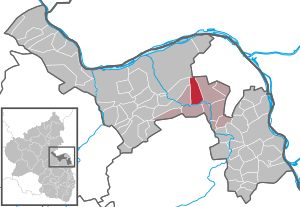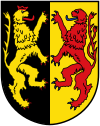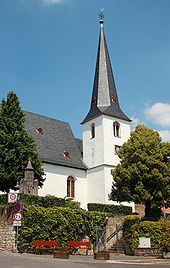Essenheim
| coat of arms | Germany map | |
|---|---|---|

|
Coordinates: 49 ° 56 ' N , 8 ° 9' E |
|
| Basic data | ||
| State : | Rhineland-Palatinate | |
| County : | Mainz-Bingen | |
| Association municipality : | Nieder-Olm | |
| Height : | 210 m above sea level NHN | |
| Area : | 10.51 km 2 | |
| Residents: | 3579 (Dec. 31, 2019) | |
| Population density : | 341 inhabitants per km 2 | |
| Postal code : | 55270 | |
| Area code : | 06136 | |
| License plate : | MZ , BIN | |
| Community key : | 07 3 39 017 | |
| LOCODE : | DE 84C | |
| Association administration address: | Pariser Strasse 110 55268 Nieder-Olm |
|
| Website : | ||
| Local Mayor : | Winfried Schnurbus (independent) | |
| Location of the local community Essenheim in the Mainz-Bingen district | ||
Essenheim is a municipality in the Mainz-Bingen district in Rhineland-Palatinate . It belongs to the Nieder-Olm community .
Geographical location
The wine town of Essenheim is located in Rheinhessen about ten kilometers southwest of Mainz . The Neumühle residential area also belongs to Essenheim . Neighboring communities are Ober-Olm in the northeast and the Mainz district of Lerchenberg just under three kilometers away , Nieder-Olm in the east and Stadecken-Elsheim in the southwest . A section of the river Selz runs along the southern boundary of the district .
history
Essenheim appears in a document under the name Hesinesheim (1023), later Heisinesheim (1026), Hesonesheim (1140), Isenheim (1147), Yesenheim (1256), Isensheim (1259), Ysenheim (1288), Eisenheim (1295), Hesenheim (1297 ) and Eysenheim (1457).
The monastery of St. Maximin near Trier owned large estates in Essenheim early on, and was owned by Emperor Heinrich II in 1023, Emperor Conrad II in 1026, Emperor Heinrich IV in 1066, Pope Innocent II in 1140 and Emperor Friedrich I. 1182 was confirmed. The St. Mariengredenstift in Mainz also owned rich estates in Essenheim at this time. The bailiwick over the place lay as a Mainz fief together with the associated goods and rights in the hands of the Lords of Bolanden . Werner IV von Bolanden had given the bailiwick in 1259 to his younger son Philipp as an inheritance, which is why he took the name Bolanden zu Essenheim .
Count Friedrich von Veldenz had installed his heir Anna (as the only heiress) together with her husband, Count Palatine Duke Stephan , in the county of Veldenz around 1422 , which also included the village of Essenheim with all its accessories. Shortly before his death, Count Friedrich von Veldenz and his son-in-law Count Palatine Duke Stephan divided their lands among the latter's children on September 23, 1444. The fourth son Ludwig, called the Black , received the county of Veldenz, which later became the Duchy of Pfalz-Zweibrücken with the Mainz ore office and thus the village of Essenheim as a feudal parcel.
The Protestant parish experienced the Reformation as early as 1533 due to its membership of the Protestant Duchy of Pfalz-Zweibrücken, making it the oldest Protestant parish in Rheinhessen. Since the Catholic cathedral chapter in Mainz was the recipient of the great tithe until the end of the 18th century , this Catholic spiritual institute was obliged to take care of the building maintenance of the Protestant church.
In the Middle Ages, Essenheim was surrounded by a village moat around the center of the settlement. This moat, filled with water and overgrown with trees and hedges, was intended to provide protection for the population. In addition, the church was surrounded by a defensive wall, behind which the population could withdraw in times of crisis.
The period of the 30-year war brought considerable destruction, epidemics and hardship. In 1620, Spanish troops set 25 houses on fire. In the winter of 1631 to 1632 the Swedes fought and quartered here. Some Swedish soldiers settled there. As a result, Swedish blood is said to have left its mark. In 1645 the fortified churchyard was stormed and looted by marauding troops and a citizen was shot. In the same year a toddler was killed by a wolf. After the end of the war, only about a fifth of the population before 1618 was still alive and the livelihoods of the population were largely destroyed. In 1666 the plague took part of the population. When the Palatinate was devastated in 1686, almost the entire village and the public buildings were destroyed. Only two houses are said to have survived the destruction at the end of the 17th century. After that, the old village of Essenheim had largely disappeared.
At the beginning of the 18th century, the village and livelihoods had to be rebuilt on a large scale. The relatively peaceful times provided a very good basis for this on the one hand, but economic development could not keep up with the population growth. Not least because of this, people have repeatedly been induced to emigrate, mostly for economic reasons.
In the 18th century, Essenheim still had its own high and blood court with a gallows. The last known executions were carried out in 1729, when three members of a family were executed there for the killing of their daughter's illegitimate child.
Essenheim with Mölsheim and later Stadecken remain as the only Rhine-Hessian places in the Duchy of Pfalz-Zweibrücken until 1733. From then on, Essenheim and Stadecken were ceded to the Electoral Palatinate by contract , with which they remained until the latter fell in the French Revolution in 1797. The French rule from 1797 to 1815, and in 1816 Essenheim becomes part of the province of Rheinhessen and belongs to the Grand Duchy of Hesse .
In the 18th century, many Essenheimers emigrated to Pennsylvania and settled there mainly in the Kreutz Creek area in what is now York County . The language of the emigrants - the Pennsylvania German - has been preserved there to this day. The best-known Pennsylvania German dialect poet Henry Harbaugh (1817–1867) also has family roots in Essenheim.
In addition to the Neumühle in the Selztal, which was operated by the water power of the Selz, there was a three-storey windmill in close proximity to the Neumühle from 1768 to the time of the French rule between 1797 and 1815.
A house and farm inventory from 1816 that has been preserved gives a precise insight into an agricultural business at the beginning of the 19th century, whose focus was on agriculture, viticulture and livestock farming.
Of interest for the understanding of village school practice are the school rules that have been preserved from 1836, from which the basic attitude of the time according to strict school regulations, pupil discipline and subordination to the strictly hierarchical world of adults emerge.
The founding of a choral society in 1846 was influenced by the political and social impressions of the Hambach Festival in 1832 and the Paul Church Parliament as well as the German Catholic movement. In 1861 a German Catholic congregation was founded, which in later decades was the second largest in the area after the Ingelheim free religious congregation in terms of membership. Of particular historical interest for the social and historical framework of the time around 1850 is a chronicle ("Chronicle of the village of Essenheim near Mainz, at the same time the history of the free religious community Essenheim") by the alderman Johannes Probst (1802-1870).
In the 19th century the local congregation had a considerable number of Jewish community members, who at times made up about 10% of the total population. Thanks to a foundation, the Jewish community was able to build its own synagogue in Klappergasse in 1857, which was desecrated in 1938, later used as a storage room and demolished in 1978. A memorial stone was placed in 1988 in memory of the synagogue at its former location. The Jewish cemetery for the community members on Wackernheimer Strasse is the only evidence of the once flourishing Jewish community, but it was desecrated several times both before and after 1945. On March 16, 2016, the artist Gunter Demnig laid his stumbling blocks in front of three residential buildings of former Jewish families.
On the occasion of the 200th anniversary of Rheinhessen in 2016, the Essenheim History Association realized a much-noticed exhibition project with the "Street of History". In ten private courtyards, the Protestant church and the old school, the historical and social development of the village over the past two hundred years was presented during the various periods of time with the various political developments.
- Population development
The development of the population of Essenheim, the values from 1871 to 1987 are based on censuses:
|
|
|
politics
Municipal council
The municipal council in Essenheim consists of 20 council members, who were elected in a personalized proportional representation in the local elections on May 26, 2019 , and the honorary local mayor as chairman. The incumbent was Hans-Erich Blodt (SPD) from 1999 to 2019. In a runoff election in 2019, he was defeated by the independent politician and journalist Winfried Schnurbus, who was supported by the FWG and the CDU.
After disputes within the SPD in Essenheim on the occasion of the local mayor election in 2019, three of the original nine SPD council members left the parliamentary group after the election. The distribution of seats in the municipal council:
| choice | SPD | CDU | FWG | GAL | independent | total |
|---|---|---|---|---|---|---|
| 2019 | 6th | 4th | 7th | - | 3 | 20 seats |
| 2014 | 11 | 2 | 5 | 2 | - | 20 seats |
| 2009 | 11 | 2 | 5 | 2 | - | 20 seats |
| 2004 | 10 | 4th | 4th | 2 | - | 20 seats |
- FWG = Free Voting Group in the Nieder-Olm community
- GAL = Green Alternative List Nieder-Olm e. V.
Community partnerships
Essenheim has had relationships with four partner communities in Champagne in France since 1978 , all of which are within a few kilometers of each other:
coat of arms
| Blazon : “Split between black and gold (yellow); in front a red-armored and crowned golden (yellow) left-wing lion and behind a blue-armored double-tailed red lion. " | |
| Reasons for the coat of arms: The coat of arms shows on the left side the Palatinate-Zweibrücker lion in gold on a black background with a red crown, on the right half the Kurpfälzer Löwen in red on a gold background with a blue tongue. The current coat of arms of Essenheim was designed in the 1950s by Prof. Leitermann from Mainz. It replaced the previous coat of arms of Essenheim, which showed Saint Mauritius (the patron saint of the church) in armor and with the coat of arms of the Electorate of the Palatinate with the Palatinate lion. For further reasons for the coat of arms, see the section #History . |
Regular events
Until 2007, the Essenheim curb took place annually at the end of August before it was postponed to the 2nd weekend in September.
Furthermore, the people of Essenheim celebrate the Canon Festival every July. In addition to selected wines, the well-attended street and courtyard festival also offers a variety of culinary highlights with musical accompaniment by various artists.
Economy and Infrastructure
Essenheim is characterized by viticulture and fruit growing , asparagus cultivation and extensive agriculture.
traffic
The community is in the immediate vicinity of the federal motorway 63 with the Nieder-Olm junction (4). A Deutsche Bahn train station is located in neighboring Nieder-Olm, from where Mainz and Alzey can be reached.
Two city bus lines and one regional bus line run directly through Essenheim: Line 55 of the MVG (Mainz to Nieder-Olm), line 75 of the MVG and ORN (Mainz to Ingelheim) and line 650 of the ORN (Mainz to Sprendlingen). The lines complement each other from Monday to Saturday in rush hour at 30-minute intervals.
See also
literature
- Stefan Mossel, Adam Braunewell, Emil Weichlein, Markus Würz: Essenheim. History and stories . Ed .: Stefan Mossel. 1st edition. Leinpfad, Ingelheim 2013, ISBN 978-3-942291-72-9 .
- Chronicle of the village of Essenheim near Mainz. At the same time the history of the free religious community Essenheim; according to the notes of Johann Probst, 1864 . Mainz: Free Religious Congregation, 1992.
- Literature about Essenheim in the Rhineland-Palatinate state bibliography
Web links
- Website of the local community Essenheim
- Local community Essenheim on the website of the Nieder-Olm community community
- History of Essenheim , regionalgeschichte.net, Institute for Historical Regional Studies, University of Mainz
Individual evidence
- ↑ State Statistical Office of Rhineland-Palatinate - population status 2019, districts, communities, association communities ( help on this ).
- ↑ State Statistical Office Rhineland-Palatinate (ed.): Official directory of the municipalities and parts of the municipality. Status: January 2019 [ Version 2020 is available. ] . S. 169 (PDF; 3 MB).
- ^ Karl Johann Brilmayer: Rheinhessen in the past and present. History of the existing and departed cities, towns, villages, hamlets and farms, monasteries and castles in the province of Rheinhessen along with an introduction. Giessen 1905.
- ↑ Stefan Grathoff, Sarah Traub: On the history of Essenheim. regionalgeschichte.net, April 7, 2016, accessed June 20, 2016 .
- ↑ a b c History of the Essenheim community. ( Memento from April 30, 2014 in the Internet Archive )
- ↑ Local community Essenheim. Verbandsgemeinde Nieder-Olm, accessed on July 30, 2019 .
- ↑ Dorf- und Geschichtsverein Essenheim: Straße der Geschichte on regionalgeschichte.net
- ↑ State Statistical Office Rhineland-Palatinate: My village, my city. Retrieved July 30, 2019 .
- ↑ Kirsten Strasser: Hans-Erich Blodt - the homebound. In: Allgemeine Zeitung. May 2, 2019, accessed July 30, 2019 .
- ↑ Allgemeine Zeitung Mainz: Schnurbus wins local mayor election in Essenheim on September 1, 2019, accessed on September 11, 2019
- ^ The Regional Returning Officer Rhineland-Palatinate: Local elections 2019, city and municipal council elections , accessed on July 27, 2019
- ↑ Allgemeine Zeitung Mainz: Essenheim SPD parliamentary group has only six members from August 22, 2019 accessed on September 11, 2019
- ^ Database of municipal partnerships. Council of Local and Regional Authorities of Europe, accessed on July 30, 2019 ( accessed via search mask).






